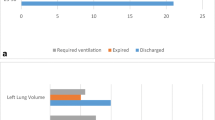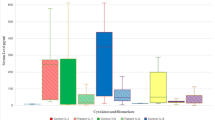Abstract
Background
Chest injury is one of the most frequent causes of death and complications in different societies. The search for a marker of lung injury is desirable for diagnosis and prognosis. This study was conducted to assess the serum level of Von Willebrand factor (VWF) and Clara cell secretory protein (CC16) as biomarker in traumatic lung injuries for diagnostic and prognostic significance.
Methods
We evaluated the demographic data of all patients of chest injury presenting to the department. Mode of injury, any intervention, and outcome were evaluated. The level of the VWF and CC16 was assessed as per protocol.
Results
The duration of this study was 1 year. The total number of patients was 96. The mean age of patients was 40.84 ± 9.89 (range 14–70 years). Male to female ratio was 5.4:1. There was a statistically significant association of VWF with diagnosis of patient. Markedly elevated levels of VWF were associated with high mortality rates (p = 0.002). The level of VWF was markedly raised in patient having duration of hospital stay more than 2 weeks (p = 0.001). There was a statistically significant association of CC16 with diagnosis of patient. Markedly elevated level of CC16 was associated with high mortality rates (p = 0.001). The level of CCI6 was markedly raised in patients having duration of hospital stay more than 2 weeks (p = 0.001).
Conclusion
VWF and CC16 appear to be useful markers for thoracic trauma. They may also be helpful for the prognosis of the patient. Further studies evaluating their role may substantiate our efforts.
Similar content being viewed by others
References
Nirula R, Pintar FA. Identification of vehicle components associated with severe thoracic injury in motor vehicle crashes: a CIREN and NASS analysis. Accid Anal Prev. 2008;40:137–41.
Devitt JH, Pagliarello G, Simons J. The involvement of anesthetists in critical care medicine. Can J Anaesth. 1990;37:S119.
Rubin DB, Wiener-Kronish JP, Murray JF, et al. Elevated von Willebrand factor antigen is an early plasma predictor of acute lung injury in nonpulmonary sepsis syndrome. J Clin Invest. 1990;86:474–80.
Broeckaert F, Clippe A, Knoops B, Hermans C, Bernard A. Clara cell secretory protein (CC16): features as a peripheral lung biomarker. Ann N Y Acad Sci. 2000;923:68–77.
Akdemir HU, Guzel A, Katu C, et al. The evaluation of different treatment protocols for trauma induced lung injury in rats. J Thorac Dis. 2014;6:66–73.
Singh YN, Bairagi KK, Das KC. An epidemiological study of victim of road traffic accident in medicolegal autopsies. JIAFM. 2005;27:166–9.
Denis CV. Molecular and cellular biology of von Willebrand factor. Int J Hematol. 2002;75:3–8.
Bajaj MS, Tricomi SM. Plasma levels of the three endothelial-specific proteins von Willebrand factor, tissue factor pathway inhibitor, and thrombomodulin do not predict the development of acute respiratory distress syndrome. Intensive Care Med. 1999;25:1259–66.
Tang N, Yin S, Sun Z, Pan Y. Time course of soluble P-selectin and von Willebrand factor levels in trauma patients: a prospective observational study. Scand J Trauma Resusc Emerg Surg. 2013;21:70.
Alaçam H, Karli R, Alici O, et al. The effects of α-tocopherol on oxidative damage and serum levels of Clara cell protein 16 in aspiration pneumonitis induced by bile acids. Hum Exp Toxicol. 2013;32:53–61.
Broeckaert F, Arsalane K, Hermans C, et al. Serum clara cell protein: a sensitive biomarker of increased lung epithelium permeability caused by ambient ozone. Environ Health Perspect. 2000;108:533–7.
Arsalane K, Broeckaert F, Knoops B, Wiedig M, Toubeau G, Bernard A. Clara cell specific protein (CC16) expression after acute lung inflammation induced by intratracheal lipopolysaccharide administration. Am J Respir Crit Care Med. 2000;161:1624–30.
Wutzler S, Backhaus L, Henrich D, et al. Clara cell protein 16: a biomarker for detecting secondary respiratory complications in patients with multiple injuries. J Trauma Acute Care Surg. 2012;73:838–42.
Author information
Authors and Affiliations
Corresponding author
Ethics declarations
Funding
No funding for this study.
Conflict of interest
The authors declare that they have no conflict of interest.
Ethical approval
All procedures performed in studies involving human participants were in accordance with the ethical standards of the institutional and/or national research committee and with the 1964 Helsinki declaration and its later amendments or comparable ethical standards. Informed consent was obtained from all individual participants included in the study.
Rights and permissions
About this article
Cite this article
Kumar, S., Pandey, A., Kumar, S. et al. Diagnostic and prognostic efficacy of Von Willebrand factor and Clara cell in traumatic lung injury. Indian J Thorac Cardiovasc Surg 34, 125–128 (2018). https://doi.org/10.1007/s12055-017-0562-6
Received:
Revised:
Accepted:
Published:
Issue Date:
DOI: https://doi.org/10.1007/s12055-017-0562-6




